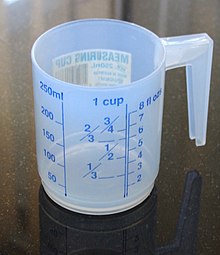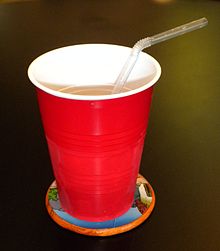

A plastic cup is a cup made out of plastic, commonly used as a container to hold beverages. Some are reusable while others are intended for a single use followed by recycling or disposal.
As well as being cheap, washable plastic cups are light and hard to break, and tend to be used for children or for travel and outside use, in gardens and picnics.
Disposable plastic cups are often used for gatherings where it would be inconvenient to wash dishes afterward, due to factors such as location or number of guests. Plastic cups can be used for storing most liquids, but hot liquids may melt or warp the material. A common design in the United States is a red plastic cup, often used for serving alcoholic beverages.
Environmental issues
Further information: Plastic waste
Most plastic cups are designed for single uses and then disposal or recycling. A life cycle inventory of a comparison of paper and plastic shows the environmental effects of both with no clear winner.
Production of 1 tonne (0.98 long tons; 1.1 short tons) of plastic cups emits 135 pounds (61 kg) of green house gases.
The choice between paper cups and plastic cups has to do with the life of the item after use. A paper cup may biodegrade faster than a expanded polystyrene (EPS) foam cup or a plastic cup. In general cardboard or paper takes one to three months for biodegradation, as the majority of the content, up to 95%, is made with wood chips. A plastic cup can take up to 90 years to biodegrade, depending on the type of plastic.
Plastic cups are made with oil, which is not a renewable source. On the other hand, paper cups can be sourced from forests which fall under sustainable management. However, plastic cups can be easier to recycle than paper cups. Paper is an absorbent material and often needs to be paired with a water-resistant material to prevent the liquid in the cup from being absorbed by the paper. Wax or PE (plastic) are the most common materials used to line paper cups. Paper cups lined with wax cannot be recycled. Paper cups lined with a PE lining can be recycled, but require specialized facilities and are not widely accepted for recycling. Disposable plastic cups are commonly produced with PET or PP plastic, which are widely accepted by recycling programs.
Plastic cups, especially those made with polystyrene, are also a possible health hazard as chemicals may leach into the beverage. This is more likely to happen with warm drinks (hot chocolate, tea and coffee) than with cold drinks.
See also
- Coffee cup
- Cup holder
- Paper cup
- Polylactic acid (used in making decomposable plastic cups)
References
- Schnurr, Riley E.J.; Alboiu, Vanessa; Chaudhary, Meenakshi; Corbett, Roan A.; Quanz, Meaghan E.; Sankar, Karthikeshwar; Srain, Harveer S.; Thavarajah, Venukasan; Xanthos, Dirk; Walker, Tony R. (2018). "Reducing marine pollution from single-use plastics (SUPs): A review". Marine Pollution Bulletin. 137: 157–171. doi:10.1016/j.marpolbul.2018.10.001. PMID 30503422.
- Hocking, M. B. (1991). "Paper Versus Polystyrene: A Complex Choice". Science. 251 (4993): 504–505. Bibcode:1991Sci...251..504H. doi:10.1126/science.251.4993.504. PMID 17840849. S2CID 33293105.
- "Paper Cups Vs. Plastic Cups: Which Is Better For Business?". 2024-07-10. Retrieved 2024-10-16.
- "Which Plastic Can Be Recycled?". Plastics For Change. 2021-05-20. Retrieved 2024-10-16.
- Dvorsky, George (March 28, 2013). "How To Recognize the Plastics That Are Hazardous To Your Health". Retrieved January 29, 2016.